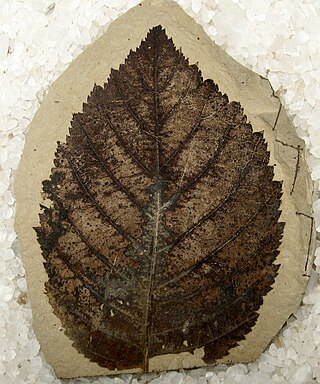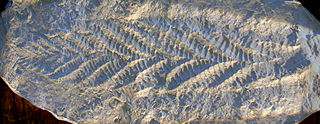Related Research Articles
Genus is a taxonomic rank used in the biological classification of living and fossil organisms as well as viruses. In the hierarchy of biological classification, genus comes above species and below family. In binomial nomenclature, the genus name forms the first part of the binomial species name for each species within the genus.

In taxonomy, binomial nomenclature, also called binominal nomenclature or binary nomenclature, is a formal system of naming species of living things by giving each a name composed of two parts, both of which use Latin grammatical forms, although they can be based on words from other languages. Such a name is called a binomial name, a binomen, binominal name, or a scientific name; more informally it is also historically called a Latin name.

The International Code of Nomenclature for algae, fungi, and plants is the set of rules and recommendations dealing with the formal botanical names that are given to plants, fungi and a few other groups of organisms, all those "traditionally treated as algae, fungi, or plants". It was formerly called the International Code of Botanical Nomenclature (ICBN); the name was changed at the International Botanical Congress in Melbourne in July 2011 as part of the Melbourne Code which replaced the Vienna Code of 2005.

Paleobotany, also spelled as palaeobotany, is the branch of botany dealing with the recovery and identification of plant remains from geological contexts, and their use for the biological reconstruction of past environments (paleogeography), and the evolutionary history of plants, with a bearing upon the evolution of life in general. A synonym is paleophytology. It is a component of paleontology and paleobiology. The prefix palaeo- or paleo- means "ancient, old", and is derived from the Greek adjective παλαιός, palaios. Paleobotany includes the study of terrestrial plant fossils, as well as the study of prehistoric marine photoautotrophs, such as photosynthetic algae, seaweeds or kelp. A closely related field is palynology, which is the study of fossilized and extant spores and pollen.

A botanical name is a formal scientific name conforming to the International Code of Nomenclature for algae, fungi, and plants (ICN) and, if it concerns a plant cultigen, the additional cultivar or Group epithets must conform to the International Code of Nomenclature for Cultivated Plants (ICNCP). The code of nomenclature covers "all organisms traditionally treated as algae, fungi, or plants, whether fossil or non-fossil, including blue-green algae (Cyanobacteria), chytrids, oomycetes, slime moulds and photosynthetic protists with their taxonomically related non-photosynthetic groups ."

In taxonomy, a nomen nudum is a designation which looks exactly like a scientific name of an organism, and may have originally been intended to be one, but it has not been published with an adequate description. This makes it a "bare" or "naked" name, which cannot be accepted as it stands. A largely equivalent but much less frequently used term is nomen tantum. Sometimes, "nomina nuda" is erroneously considered a synonym for the term "unavailable names". However, not all unavailable names are nomina nuda.

The International Association for Plant Taxonomy (IAPT) is an organization established to promote an understanding of plant biodiversity, facilitate international communication of research between botanists, and oversee matters of uniformity and stability in plant names. The IAPT was founded on July 18, 1950, at the Seventh International Botanical Congress in Stockholm, Sweden. The IAPT headquarters is located in Bratislava, Slovakia. Its president, since 2017, is Patrick S. Herendeen of the Chicago Botanic Garden; vice-president is Gonzalo Nieto Feliner of the Real Jardín Botánico, Madrid; and secretary-general is Karol Marhold of the Plant Science and Biodiversity Centre, Slovak Academy of Sciences, Bratislava.
Botanical nomenclature is the formal, scientific naming of plants. It is related to, but distinct from taxonomy. Plant taxonomy is concerned with grouping and classifying plants; botanical nomenclature then provides names for the results of this process. The starting point for modern botanical nomenclature is Linnaeus' Species Plantarum of 1753. Botanical nomenclature is governed by the International Code of Nomenclature for algae, fungi, and plants (ICN), which replaces the International Code of Botanical Nomenclature (ICBN). Fossil plants are also covered by the code of nomenclature.
In botany, the correct name according to the International Code of Nomenclature for algae, fungi, and plants (ICN) is the one and only botanical name that is to be used for a particular taxon, when that taxon has a particular circumscription, position and rank. Determining whether a name is correct is a complex procedure. The name must be validly published, a process which is defined in no less than 16 Articles of the ICN. It must also be "legitimate", which imposes some further requirements. If there are two or more legitimate names for the same taxon, then the correct name is the one which has priority, i.e. it was published earliest, although names may be conserved if they have been very widely used. Validly published names other than the correct name are called synonyms. Since taxonomists may disagree as to the circumscription, position or rank of a taxon, there can be more than one correct name for a particular plant. These may also be called synonyms.

Vladimir Mitrofanovich Arnoldi was a Russian professor of biology. He was a Corresponding Member of Russian Academy of Sciences and scientifically listed a number of valuable plants in Malaysia.

Takenoshin Nakai was a Japanese botanist. In 1919 and 1930 he published papers on the plants of Japan and Korea, including the genus Cephalotaxus. During the Japanese occupation of the (former) Dutch East Indies Takenoshin Nakai was between 1943 and 1945 the director of 's Lands Plantentuin in Batavia (now: Bogor Botanical Gardens in Bogor.

Form classification is the classification of organisms based on their morphology, which does not necessarily reflect their biological relationships. Form classification, generally restricted to palaeontology, reflects uncertainty; the goal of science is to move "form taxa" to biological taxa whose affinity is known.
Phytotaxa is a peer-reviewed scientific journal for rapid publication on any aspect of systematic botany. It publishes on a wide range of subjects, but focuses on new species, monographs, floras, revisions, reviews, and typification issues. Phytotaxa covers all plant groups covered by the International Code of Nomenclature for algae, fungi, and plants, including diatoms, fungi, algae, lichens, mosses, hornworts, liverworts, and vascular plants), both living and fossil.
Authors of Plant Names by Richard Kenneth Brummitt and C. Emma Powell, 1992, is a print database of accepted standardized abbreviations used for citing the author who validly published the name of a taxon. The database is now maintained online at the International Plant Names Index. The book provides recommended abbreviations for authors' names that help to distinguish authors with the same surname when giving the full name of a taxon. It deals authors who validly published the name of a flowering plant, gymnosperm, fern, bryophyte, algae, fungi or fossil plants. Prior to its publication in 1992, many abbreviations for authors to be cited could be found in Taxonomic literature. A selective guide to botanical publications and collections with dates, commentaries and types. by F. A. Stafleu & R. F. Cowen, 1976–1988.

A scientific collection is a collection of items that are preserved, catalogued, and managed for the purpose of scientific study.
Paul Friedrich Reinsch was a German phycologist and paleontologist.
This article contains papers in paleobotany that were published in 2016.
Tetraphyllum is a genus of flowering plants belonging to the family Gesneriaceae. As of April 2021, there was no consensus as to whether the correct scientific name for the genus is Tetraphyllum or Tetraphylloides, some sources using the former and some the latter.

Kadenicarpus is a genus of flowering plants belonging to the family Cactaceae. It is native to eastern Mexico. It has been synonymized with Turbinicarpus but molecular phylogenetic studies have supported its monophyly and separation from that genus.
Eliza Catherine Jelly was an English bryozoologist. She was one of the first women to work and publish in the field of bryozoology. Her 1889 text The Synonymic Catalogue of the Recent Marine Bryozoa is still used as a reference material.
References
- ↑ Alexander, Doweld (December 2015). "THE INTERNATIONAL FOSSIL PLANT NAMES INDEX (IFPNI): First Year Report" (pdf). International Organisation of Palaeobotany. Retrieved 2022-07-01.
- ↑ Doweld, Alexander B. (2016). "The International Fossil Plant Names Index (IFPNI): A global registry of scientific names of fossil organisms started" (pdf). The Palaeobotanist. 65: 203–208. Retrieved 2022-07-01.